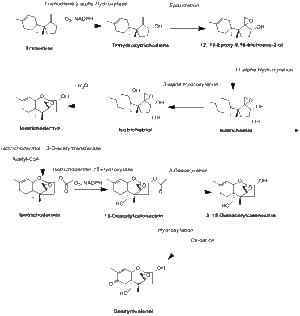Vomitoxin facts for kids
Vomitoxin is a natural poison made by tiny living things called fungi. These fungi belong to a group called Fusarium. You can often find these fungi growing on important food grains. Grains like wheat, rice, barley, and corn can all be affected.
Once the fungi grow on the grains, the vomitoxin can stay in them. This means that foods made from these grains, like flour or even beer, might contain vomitoxin. If people or animals eat food with vomitoxin, they can feel sick. They might experience vomiting, feel dizzy, or have a stomach ache. Luckily, these problems usually go away after a short time.
Contents
What is Vomitoxin?
Vomitoxin is not just one type of poison. There are actually more than 140 different kinds! But don't worry, only a few are commonly found. The most well-known ones are called deoxynivalenol, nivalenol, and T-2 toxin.
Deoxynivalenol and Heat
One type, deoxynivalenol, is very strong. It does not break down easily when heated. You could cook it at very high temperatures, like 350°C (662°F), and it would still be a poison.
However, some cooking methods can help. For example, if you boil grains with deoxynivalenol, some of the poison can move into the water. If you then throw the water away, you remove some of the vomitoxin. Scientists believe that deoxynivalenol does not cause cancer.
Vomitoxin and Animals
When animals eat grains or food that has vomitoxin, they usually don't die. But they often eat less food than usual. This means they don't grow as big or as fast as they should.
Vomitoxin can also stay in the animal's body. For example:
- Chickens that eat vomitoxin might lay eggs that have some vomitoxin in them.
- Pigs that eat vomitoxin can have it in their meat.
- Cows that eat vomitoxin might give milk that contains it.
Good news is, the amount of vomitoxin in animal products is usually much less than what was in the grain the animal ate.
Stopping Vomitoxin from Spreading
Vomitoxin and the fungi that make it can cause big problems for farmers. They can lose a lot of money because their crops are damaged. For example, in Canada, Fusarium fungi on wheat cost farmers millions of dollars each year.
Farmers use several ways to stop vomitoxin from getting into our food:
- Crop Rotation: They can change the types of crops they grow in a field each year. This helps to break the life cycle of the fungi.
- Healthy Seeds: Farmers can plant seeds that have been checked to make sure they don't have Fusarium fungi on them.
- Strong Crops: They can choose types of crops that are naturally strong and can fight off Fusarium infections.
- Fungicides: Sometimes, farmers spray special chemicals called fungicides on their crops. These chemicals help to kill the harmful fungi.
- Cleaning Crops: When harvesting, infected grains are often smaller and lighter. Farmers can use special machines called combine harvesters to blow air on the crops. This blows away the lighter, infected grains, leaving the heavier, healthy ones behind.
Related pages


